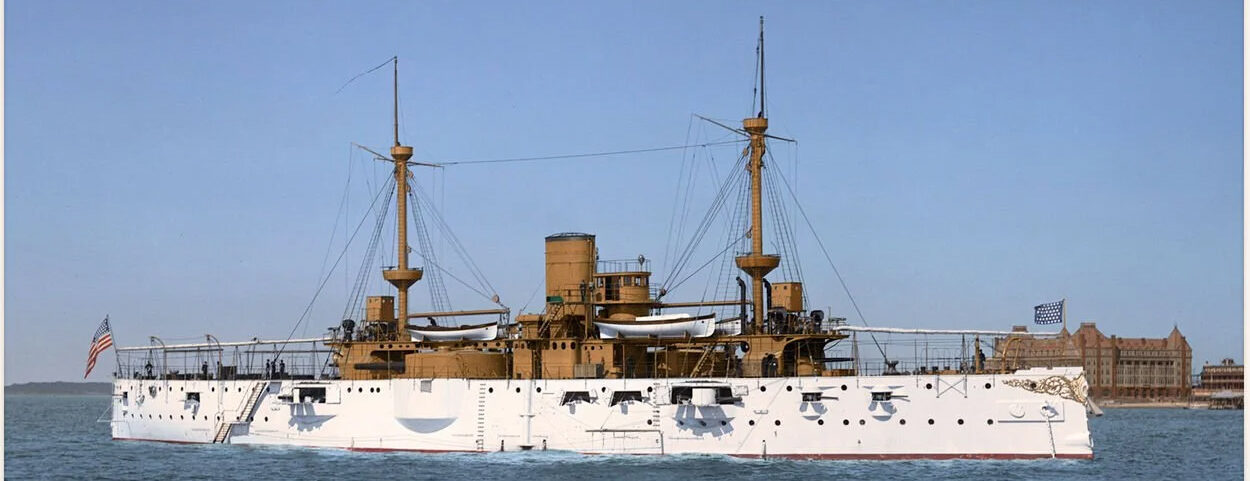
 USA – pre-dreadnought 1895-1911
USA – pre-dreadnought 1895-1911WW1 US Battleships:
USS Maine | USS Texas | Indiana class | USS Iowa | Kearsage class | Illinois class | Maine class | Virginia class | Connecticut class | Mississippi class | South Carolina class | Delaware class | Florida class | Arkansas class | New York class | Nevada class | Pennsylvania class | New Mexico class | Tennessee class | Colorado class | South Dakota class | Lexington classUSS Texas 1890 – The very first USN battleship.
After the American Civil war ended in 1865, what was later called the “old navy” started to decrease and over the years, few new ships were built, so much so that in 1883, the Congress was asked two authorize the first modern USN cruisers (the Atlanta class), and many commerce raiding masted cruisers followed. But it’s the realization that Brazil had noew its first modern ironclad, the Riachuelo, that rang the alarm for the admiralty, which had nothing to compare. From there, the Congress granted a request in 1888 to built a coastal ore-dreadnought, which became USS texas (BB1) the first modern sea going USN battleship. Here is this story. #USN #newnavy #USNavy #usstexas #WWI
The venerable “Old Hoodoo”
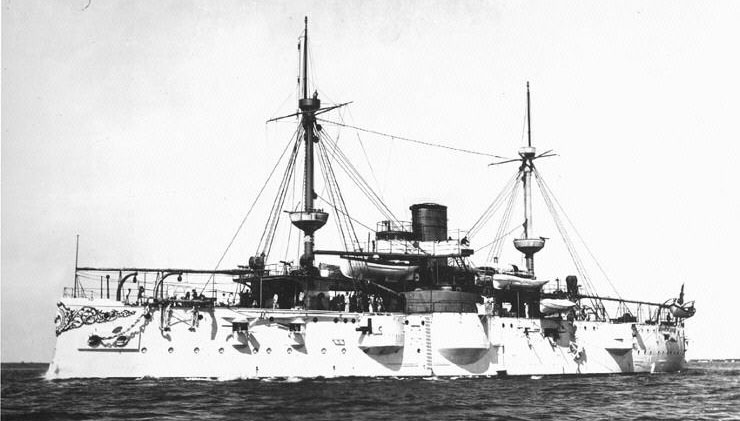
USS Texas was a pre-dreadnought, the very first planned from 1888 by the United States, and largest warship ever commissioned so far. This was a response to the new warships acquired by rival South American nations, Brazil precisely. The new ship was also intended to fuse the most recent technological advances from Europe and start a complete overhaul of the North American maritime strategy and long-term planification.
One characteristic of the new US design was of course a redical departure over pas monitors, which were the default USN ironclads intil then, and instead of a greater freeboard and keeping turrets fore and aft, USS Texas was designed to have her main battery placed en echelon, close together, allowing the best compromise in broadside, chase and retreat while concentrating armour amidship, based on the limited tonnage authorized.
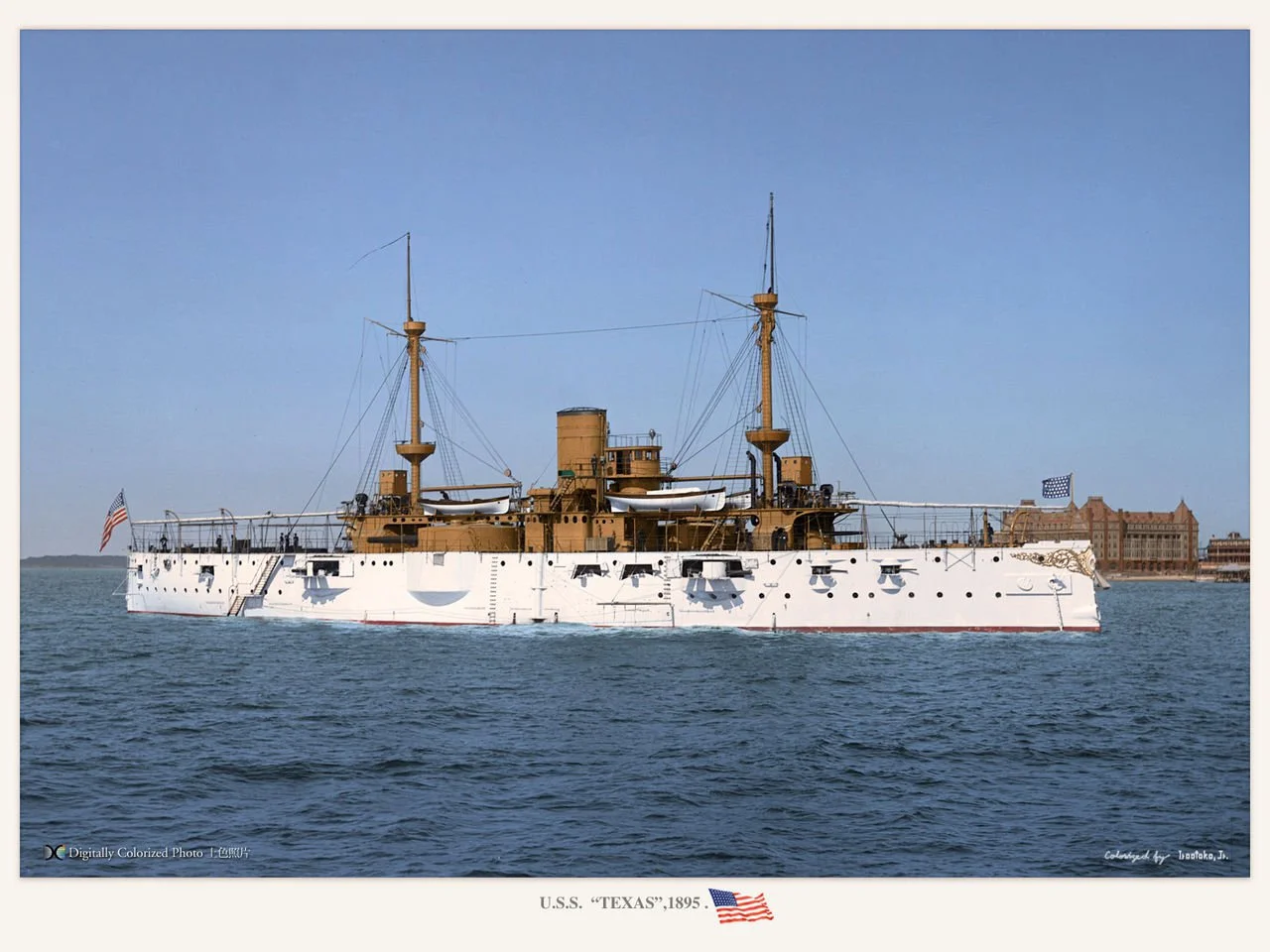
USS texas Colorized by Irootoko jr
Nonetheless, due to the state of U.S. industry at that point and lack of experience in that matter, design and construction of USS Texas dragged on, and when ultimately commissioned, she was already obsolete. In any case, with USS Maine started as an armored cruiser, both became the bedrock of the “new navy” consecrated by the war of 1898.
USS Texas fostered a standing “cursed” or unfortunate reputation after a few mishaps from the get-go, often dubbed “Old Hoodoo” with incidents during construction, a grounding off Newport, flooding while moored in New York City. But her notoriety improved with the Spanish-American War, blockading the bay of Cuba and taking part on the battle of Santiago de Cuba.
She did not see WWI however. Renamed San Marcos in 1911 (freeing BB-35’s name) she became a crane ship, and then a target ship on Chesapeake Bay until WW2 and was later blasted by explosives but refloated and scrapped in 1959.
USS Texas was seen as a first-and major step in this American maritime plan, BB-1 was succeeded by many generations until USS Wisconsin (BB-64) laid down in January 1941. The latter had almost ten times her displacement, was twice as fast and carried an armament that was unimaginable at the time, both in range, precision and global firepower. This represented a 50 year gap in technology. Unfortunately, USS Maine famously exploded in Cuba whereas USS Texas, despite surviving until 1945 as San Marcos, was not preserved.
Development and order
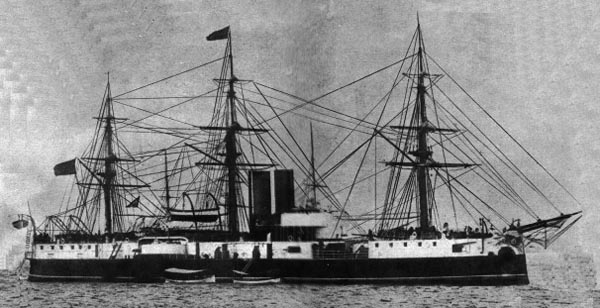
Riachuelo, there just completed, which started it all.
The delivery of Riachuelo in 1883 by Great Britain to the Brazilian Navy, a stepup of the naval rivalry with Argentina and Chile alarmed the United States government. Riachuelo was indeed the most powerful ship in the Western Hemisphere. The admirakty new she could defend its own ports with monitors, some quite old, but not going out at sea to fight a possible opponent, and Chairman of the House Naval Affairs Committee, Congressman Hilary A. Herbert decounced this in Congress by stating
“if all this old navy of ours were drawn up in battle array in mid-ocean and confronted by the Riachuelo it is doubtful whether a single vessel bearing the American flag would get into port.”
Meeting the Brazilian potential threat
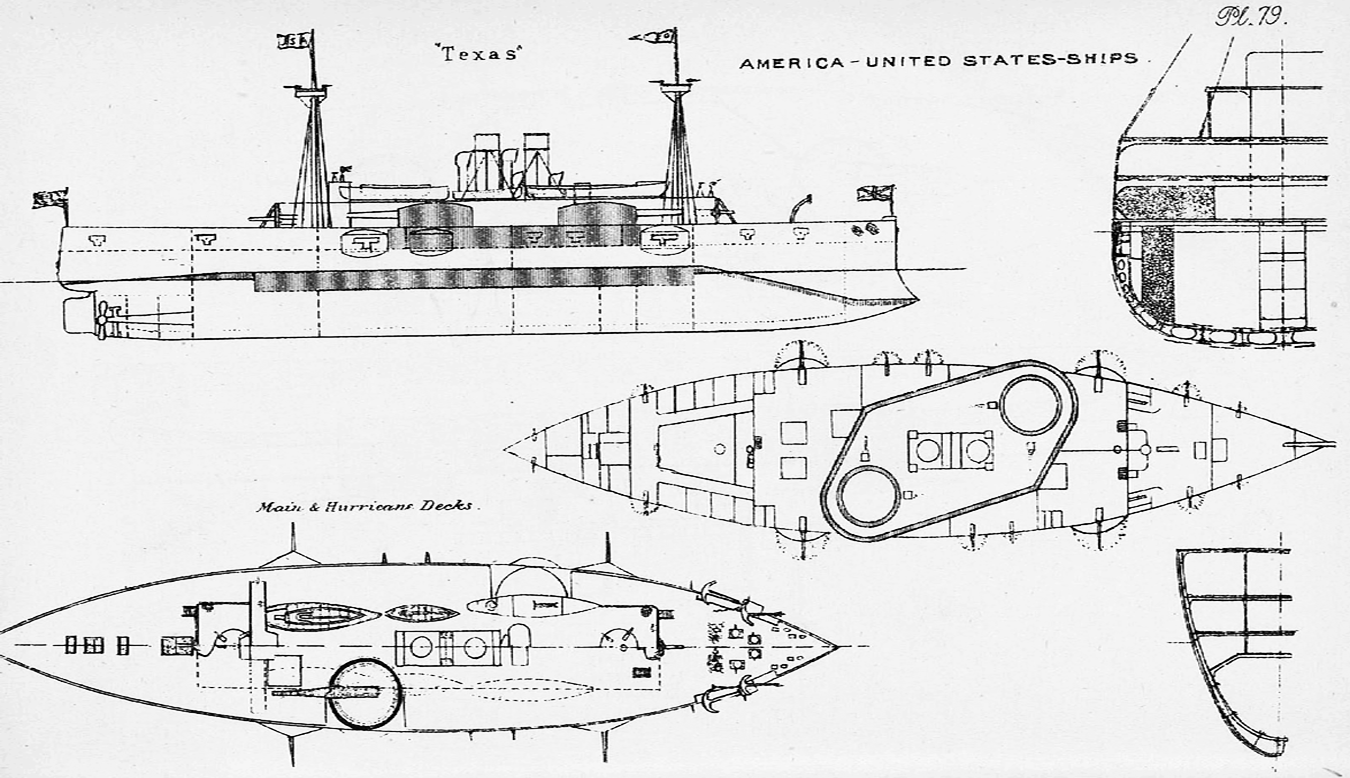
Description of USS Texas in Brassey’s naval annual, 1894
The Navy Advisory Board, which new such ironclad could effectively blockade the American coast started planning two coastal armoured ships to back in 1884. Riachuelo was known since her launch indeed on June 7, 1883. The Brazilian planned tw sister ships, Riachuelo and Aquidaba (which was completed in 1885). Both new USN ships had to face constraints though: They had to fit within existing docks, which were rather small (otherwise the construction of new ones would had cause an extra delay of several years), and to have a shallow draft to reach most American ports and bases at the time. Minimum speed was set to 17 knots (31 km/h; 20 mph), a bit better than the 16.7 knots in official documentations presented by Samuda Bros for the Riachuelo class.
The new battleships were however constrained to displace 6,000 long tons (6,100 t) by a congress decision. They were optimized for end-on fire with gun turrets in échelon and sponsons over the sides, enabling them to fire across the deck, like the Riachuelo and Aquidabã but also the German Sachsen class or the German-built Dingyuan class, but most British ironclads of the time, included the ill-fated masted HMS Captain.
Splitup between Maine (AC1) and Texas (BB1)
However after many discussions in 1884, plans changed again and the first of these two ships was laid down for as a battleship substitute instead, faster and carrying 10 in (250 mm) guns. She was eventially USS Maine (AC1), the first USN armoured cruiser. The other one was instead more of a conventional ironclad armed with two 12 in (300 mm) guns, named USS Texas, a symbol of hardly gained freedom, and first named in honor of this state in the USN.
The US Navy Department still had the great lines but no precise design, and not having the design bureau nor experience in that field, was condemned to look over the Atlantic, more experienced builders in UK, France, Germany or Italy. It started an international design competition. The one retaoned, was Naval Construction & Armaments Company, Barrow-in-Furness in Cumbria, UK. This was an odd choice: It was indeed an experienced yard which already signed many liners, but which had no previous experience in designing battleships. The first ever built here was IJN the pre-dreadnought IJN Mikasa for Japan, launched in 1898. A better choice should have been to contact Portsmouth or Pembroke DyD which signed already the colossus, Agamemnon class and Inflexible in the 1880s.
A battery arrangement soon obsolete

Anyway, the winning design just precised the placement of the forward turret on the port side, and aft starboard and many recalculationd for the superstructure to be separated into three parts, to allow effective cross-firing. Still they could not fire ability to fire to the opposite beam fully, their arc of fire being reduced. As designed, deck or superstructure were not particularly reinforced to withstand muzzle blasts: It was shown at the Battle of Santiago de Cuba.
Five years before completion these issues were already known and criticized in European admiralties, and the echelon was abandoned, making Texas obsolete by this arrangement. The Bureau of Construction and Repair later created and its technical wing, the Board on Construction, considered a complete reconstruction with centerline main guns in two single or a single twin one forward, but construction by then was too far advanced. Navy Secretary Benjamin Tracy only wanted detail improvements to speed up construction.
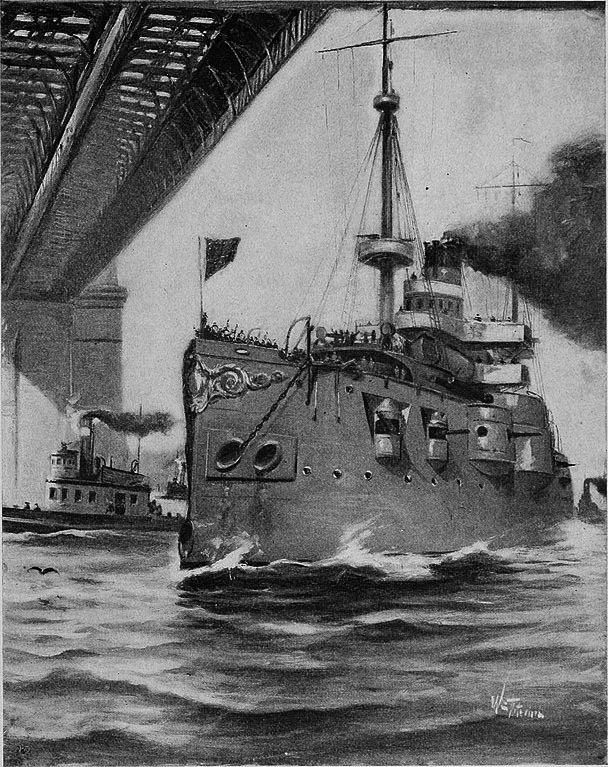
USS Texas under the New York bridge
Construction
USS Texas was authorized by the U.S. Congress on 3 August 1886. The start of construction was delayed by eight months due to redesigns, the admirakty beingg concerned by her stability and other characteristics. Her keel was laid down Norfolk Naval Shipyard, Portsmouth, Virginia on 1 June 1889. Norfolk Navy Yard would soon delivered many other battleships, this time in a shorter span. She was launched on 28 June 1892, baptised by Miss Madge Houston Williams, granddaughter of Sam Houston, the founder of Texas. Being launched on by June 1892 (nearly four years later !) and completed a further three years afterwards befor her commission on 15 August 1895 seems quite long indeed. It was rare for British and German standards, twice as shorter in span, but not unusual in French and Italian navies though. Like in the latter case, redesigns was the main cause, but other issues as well. Her first captain was Henry Glass, which went through sea trials and many fixes.
Detailed design of USS Texas
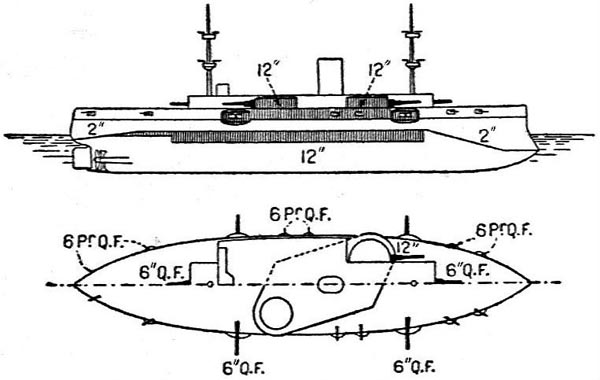
Hull and general design
Texas’ hull measured 308 feet 10 inches (94.1 m) overall in lenght, for 64 feet 1 inch (19.5 m) in beam, so around a 2/10 ration. Maximum draft was 24 feet 6 inches (7.5 m),a bit more than anticipated for coastal operations. She displaced 6,315 long tons (6,416 t) when fully loaded. Metacentric height was 2.54 feet (0.8 m). Her hull was almost primastic in shape for better water entry and flow, with the greatest beam amidship, around the barbettes. The hull was also flush deck, but on two deck levels for better seaworthiness. As usual for that generation of ships, she was fitted with a ram bow. The latter comprised a bottom opening for the froward torpedo tube and the top was heavily decorated, another trait of the time.
Armour protection layout
Harvey armor was used for the most ensible external components of the protection scheme. Here as follows:
-Main waterline belt 12 inches (300 mm), tapered to 6 in (152 mm) on its lower edge, 188 feet (57.3 m) long, 7 feet (2.1 m) high.
-It was 3 feet (0.9 m) under the waterline, angled inwards on 17 feet (5.2 m) down to 8 inches (203 mm) thick for raking fire.
-Transverse bulkheads, closing the citadel 8 in (203 mm) thick
-Protective deck 2 inches (51 mm) thick, sloped downwards on both ends and to the sides at 3 inches (76 mm).
-Gun deck 12 in diagonal armored citadel protecting the turret machinery and CT supports, 2-inches thick.
-Barbettes 1–3 in (25–76 mm) – more protective caps.
-Circular turrets walls 12 in (300 mm) thick plus 1 in (25 mm) roofs
-Turret hoists, voicepipes and electrical leads encased in armored tubes.
-Conning tower 9 in (229 mm) thick walls.
-Lateral hydraulic pipes underside deck unprotected, but in armored tubes after 1902 refit, 1-2 in.
-No armor above the main belt or hull ends. No consideration was given at the time to experimental rapid-fire guns with HE shells.
-Her underwater protection was already developed, with two wing compartments either side of the machinery spaces
-Centerline, longitudinal tight bulkhead separating VTE engines and boilers*.
-A double bottom protected most of her hull, extended to the lower edge of the armor deck.
*Asymmetric flooding however were risky to stability without more refined compartimentation.
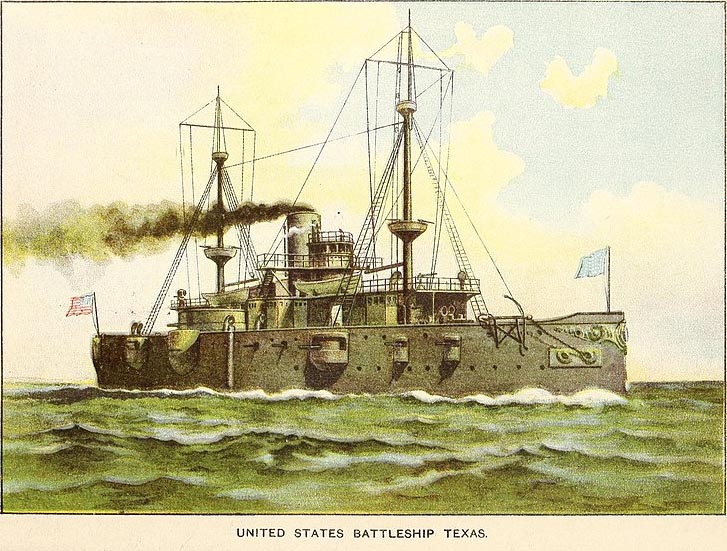
Powerplant
Texas wa given a set of VTE (Vertical Triple-Expansion) steam engines from Richmond Locomotive and Machine Work in Virginia. These were inverted VTE, with an expected output of 6,000 shp but in trials, 8,610 indicated horsepower (6,420 kW) wrere achieved. Two propeller shafts only, with four-bladed narrow type blades propellers. They used steam coming from four double-ended cylindrical boilers. Working pressure was 175 psi (1,210 kPa; 12.3 kgf/cm2).
On trials, of course she was pushed to reach 17.8 knots (33.0 km/h; 20.5 mph), so better than her contract speed of 17 knots (31 km/h; 20 mph).
For autonomy, she carried 877 short tons (796 t) of coal and two Edison electric dynamos powering searchlights and for interior lighting.
Armament
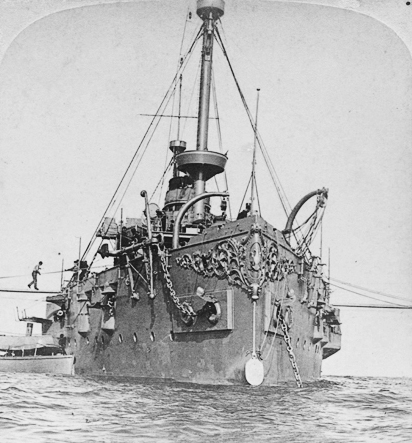
Texas Decorated prow
It was consistent, between two single 12 in (305 mm) guns, half of what contmpprary battleships had, but more in line with coastal battleships and monitors of the time, compensated by sic rapid-fire 6 in (152 mm) guns and completed to deal with torpedo boats, with no less than twelve single QF 6-pdr (57 mm (2.2 in)) guns, four single 1-pdr 37 mm (1.5 in) revolving guns, six single 1-pdr guns. As usual for the time she also carried four 14 in (356 mm) torpedo tubes.
Main: 2×1 12-in
The main armament comprised two 12-inch (305 mm)/35 caliber Mark I guns. They were mounted in single Mark 2 hydraulically powered turrets, encased in a circular armored redoubt. This was very reminiscent of monitors or Coles turrets for that matter. Both were placed on the broadside in échelon as said, overhanging on large sponsons to give them a theoretical 360 dregree fire. Two can be brought to bear fore and aft, but broadside fire was impossible for the opposite turrets at many angles.
Maximum elevation was 15°, depression −5°. Eighty rounds per gun were carried in the hull. These were 870-pound (394.6 kg) shells, exiting the barrel at 2,100 ft/s (640 m/s) to 12,000 yards (11,000 m) at max. elevation. Each had a fixed rammer below and outside the turret and so loading obliged the gun each time to be angled down in a single positions of 0° elevation. Before 1898, advances in artillery had this modified to load at any angle, greatly improving reload speed, which was initially one shot every five minutes at best.
Notes:
180 rounds in all was not impressive if they had to fend off many opponents in a prolongated battle. The weak muzzle velocity was not going to favor penetration power, and at max elevation, many naval guns of the time were far better an any way. And for those of their potential opponents, the Riachuelo class, they had four 240 mm (9.45 in) guns in two turrets, made by Vickers Armstrong, which could fire a 380 pounds (172.37 kg) shell at 10,000 yards. So this was quite a fair match, even against the two of them.
Secondary: Six 6-in
Four of these six 6-inch (152 mm) guns were in hull casemates along the sides, fore and aft of the main sponsons. The remainder two were mounted on the main deck, in open pivot mounts with light shields. The latter differed as the were 35 caliber, while casemate guns were 30 caliber. Elevation is estimated to be +12°. Shells weighed 105 pounds (47.6 kg), high explosive. They existed the barrles at a muzzle velocity of 1,950 ft/s (590 m/s). Range was estimated under 9,000 yd (8,200 m) at maximum elevation.
Tertiary: 6 and 1-pdr
The antitorpedo battery was quite consistent:
-Twelve 57 mm (2.2 in) six-pounder guns in casemates along the hull, firing a 6 lb (2.7 kg) shell at 1,765 ft/s (538 m/s) (20 rpm), 8,700 yd range.
-Two 37 mm (1.5 in) Hotchkiss 5-barreled revolving guns, fore and aft superstructure.
-Two lighter 37 mm Driggs-Schroeder 1-pdr guns on the fighting top. They fired a 1.1 lb (0.50 kg) shell at 2,000 ft/s (610 m/s) to 3,500 yd (3,200 m), 30 rpm.
Torpedo Tubes:
Texas carried four 14-inch (356 mm) torpedo tubes: They were all placed above water to avoid potential watertight weak points. The pattern was also classic for the time, in lozenge:
One bow, one stern tube, two broadside tubes, aft of the hull.
Torpedo Boats:
Engineers planned also that she could carry two small steam torpedo boats armed with a 1-pdr gun plus trainable torpedo tube, the same carried by USS Maine. However without surprise, the prototype built for the latter performed so poorly that this prospect was cancelled. The concept of toprpedo boat mothership was tried in the 1880s by UK, France or Italy with the same disappointment. Seductive concept on paper, this was a complete failure on practice.
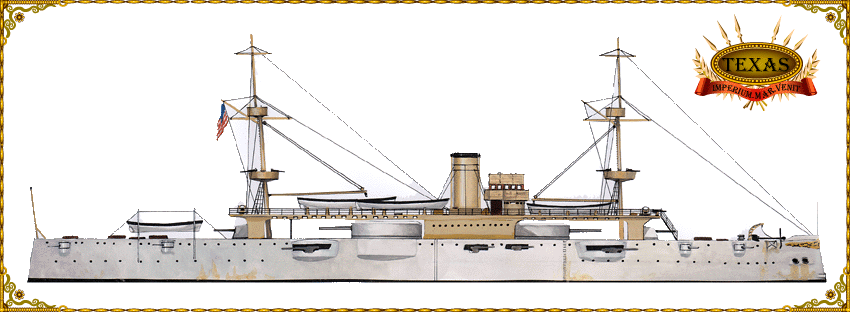
Author’s illustration
‘USS Texas’ class specs. 1895 |
|
| Displacement | 6,316 tons, 6,490 tons FL 1898 |
| Dimensions | 308 x 64 x 24 (94 x 19.5 x 7.5 m) |
| Propulsion | 2 shafts TE steam engines, 4 boilers, 8,610 ihp (6,420 kW) |
| Speed | 17.8 knots (33 km/h; 20.5 mph), Range: ? |
| Armament | 2× 12-in, 6× 6-in, 12× 36-pdr, 10x 1-pdr, 4x 14-in TTs |
| Armor | Belt 12in, Deck 1-3in, Citadel 12in, Turrets 3in, CT 9in, Bulkheads 8in. |
| Crew | 398 officers & sailors |
USS Texas in service
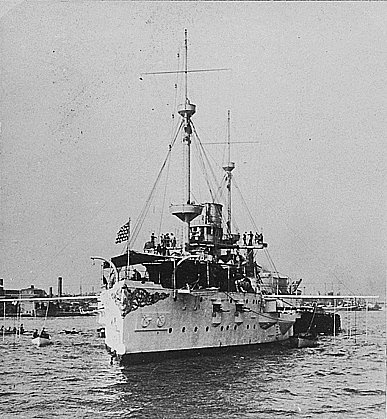
Texas prow
USS Texas was commissioned on 15 August 1895 and started her initial sea trials with Captain Henry Glass in command. Many issues had been found so that she returned to the drydock in the New York Navy Yard. These were mostly structural flaws. Foors buckled, the cement near the keel cracked due to vibrations. So her floor brackets were reinforced and cement repaired. An enquiry was made on her structural integrity in January 1896. The Board recommended further strengthening, which cost an additional $39,450 over 100 days. The Board enquired about the effect of these on stability notably, and in February were answered that it added 31 long tons (31 t), causing her draft to augment to 2 in (51 mm) and change her metacentric height to 2.76 ft (0.84 m).
During another trial she ran aground near Newport (Rhode Island) in September the same year (1896). It was a human error compounded by a signal failure and officers were reprimanded. She returned in the NYNY for the third time. Not yet into the drydock, she saw the yoke securing her main injection valve (starboard engine room) broken on 9 November 1896, repaired. She was flooded due to the removal of the receiving pipe. The watertight doors as well as the voicepipes were leaking and water also seeped through the electrical cables holes in the bulkhead. This flood will spread to the other engine and boiler rooms and coal bunkers, magazines, shell rooms. The result was she ship completely flooded and settled to the bottom, and salvage efforts were considerably difficult. Water was eventually pumped out and divers had to remove 300 short tons of coal to lighten her before she could proceed to the drydock.
After new repairs she was at last assigned to the North Atlantic Squadron. Her role was to patroll the Eastern Seaboard. By February 1897, she made her first cruise to the Galveston in Texas, and visited New Orleans. However while in Galveston on 16 February 1897 the local pilot was mistaken about the depht here and she buried herself into a mud bank. Assistance came from the U.S. Revenue Steamer Galveston, but she could do nothing. Later by both using her port anchor and a tug she coukd be freed. Such an unlucky ship was soon called by the crews “Old Hoodoo”.
Back to the Eastern Seaboard in March 1897, she was not involved in operations until 1898, after a refit was done in June 1897, seeing her bow and stern torpedo tubes removed, better telescopic sights added to her turret roofs in the summer and in January, she visited Key West in Florida, proceeded to Galveston by mid-February. Via the Tortugas in March she arrived in Hampton Roads on 24 March. But soon, international news had her prepared for war, for the first (and last) time in her career.
Spanish–American War
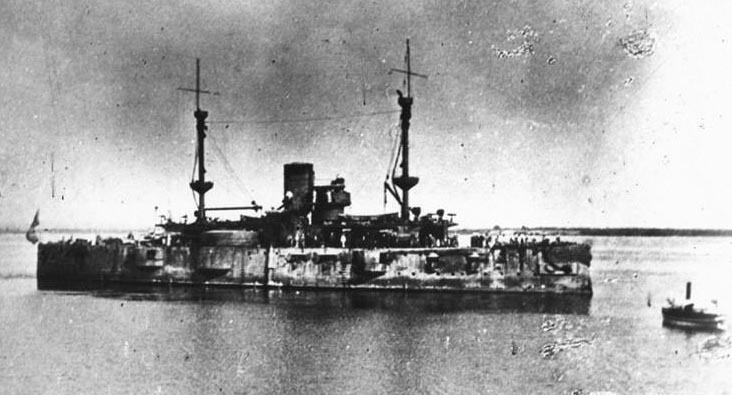
Texas in Cuban waters, May–July 1898
The spring saw a state of war being declared between the United States and the Spanish Empire. It was trigerred by conditions in Cuba denounced by the press, and the supposed destruction of USS Maine in Havana harbor attributed to Spanish authorities in February. On 18 May USS Texas was prepared for war under command of Captain J. W. Philip. She headed for Key West, close to Cuba. On the 21th she proceeded off Cienfuegos in Cuba, joing the Flying Squadron engaged in a blockade. She returned to Key West for coal and returned this time to Santiago de Cuba on the 27th, patrolling until 11 June, and probing Guantánamo Bay, offering gunnery support to Marine landings.
The 12 June, she landed three field pieces she carried and M1895 Colt–Browning machine guns for Marines Lt. Col. Robert W. Huntington. For five weeks, she patrolled between Santiago de Cuba and Guantánamo Bay and on 16 June took part with USS Marblehead to a shelling of South Toro Cay Fort, Guantánamo Bay. They ruined it in an hour.
On 3 July, while off Santiago de Cuba she was signalled a sortie on force of Admiral Cervera. She opened fire as soon she spotted these ships, targeting the armored cruisers Vizcaya and Cristobal Colon, and with USS Iowa, Gloucester, and Indiana, fired with her secondaries on approaching torpedo-boat destroyers (Audaz notably).
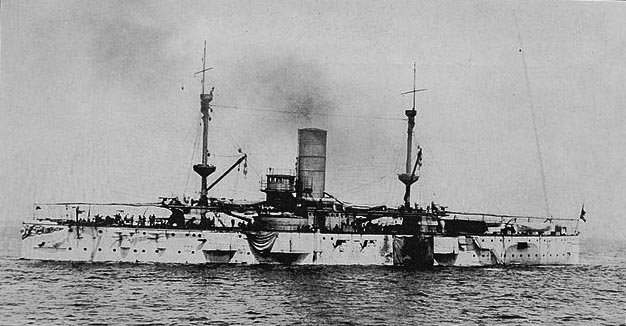
The latter were soon silenced and obliged to beached themselves not to sink, whtoit achieving anything. Montoyo’s four armored ships meanwhile were battered to submission. In turn, they sheered off toward the shore to beach. This was the end of the Cuban Spanish Fleet. Texas however was not unscathed from this sole battle in her career: She had received a single 6 in (152 mm) HE shell on her starboard side, above the main deck, above the ash hoist. Fragments damaged the latter, destroyed air shafts doors and bulkheads, crippling the adjacent structure. But there was not injury.
After the surrender at Santiago and before the peace protocol was signed in Washington, DC, in August, Texas was back in New York, on 31 July. Captain Philip was promoted to Commodore on 10 August and by late November and December, she operated off Hampton Roads December, returning to her peacetime routine on the Atlantic coast, between the northeastern coast, and Caribbean, but visiting also San Juan, Puerto Rico, and Havana.
Post-war service
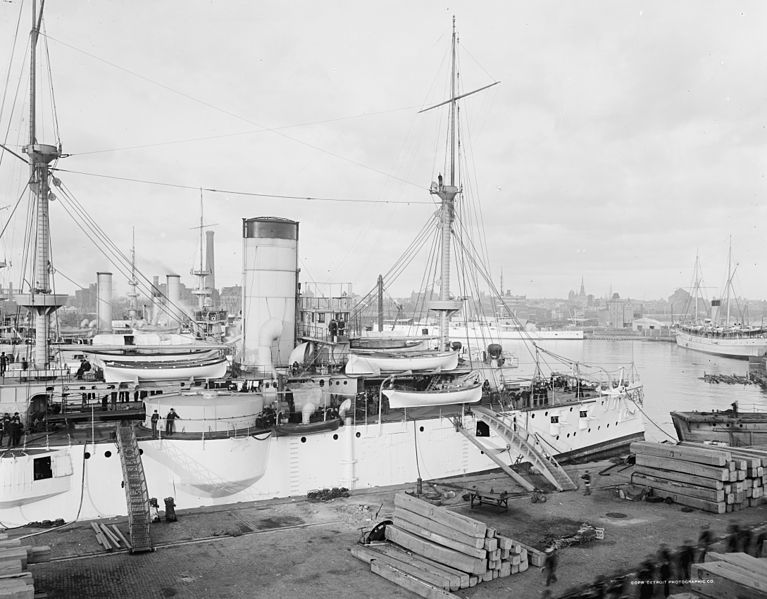
USS Texas at Brooklyn Navy Yard circa 1903
USS Texas in 1900 was clearly not to the level of the new battleships built in between for the USN. She was decommissioned for a lengthy refit, starting on 3 November 1900, at Norfolk NYD, until 3 November 1902. The modifications included the following:
-Funnel and topmasts raised (wireless telegraphy installed also).
-Protection for her 12 in (300 mm) ammunition hoists doubled
-Broadside torpedo tubes removed.
By February 1904 in trials she showed only capable to reach 13.9 knots, even under forced draft.
She returned for a refit in 1904 this time to have four 6 in (150 mm)/30 removed and replaced by new 35-caliber, new generation guns, and two 1-pounder guns removed. With extra accomodations she became flagship, Coast Squadron, until 1905, so not force to make patrols as before.
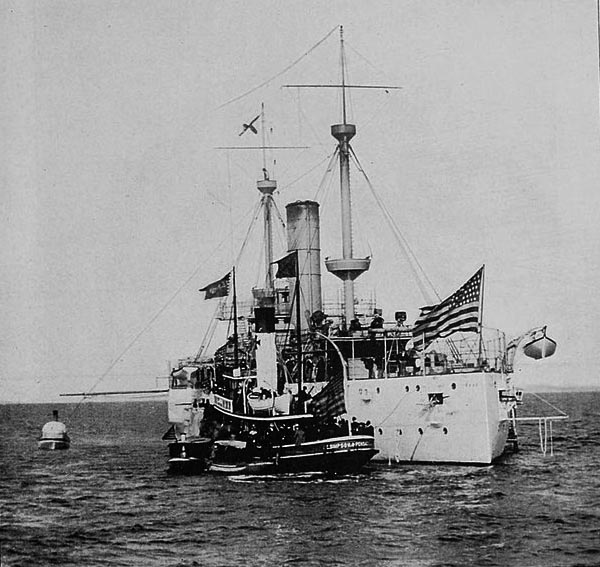
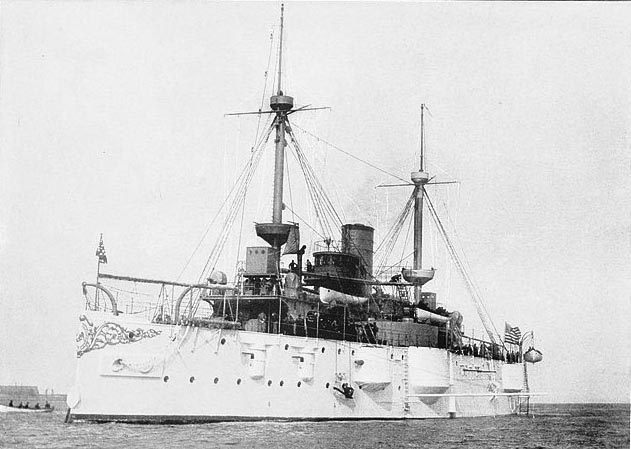
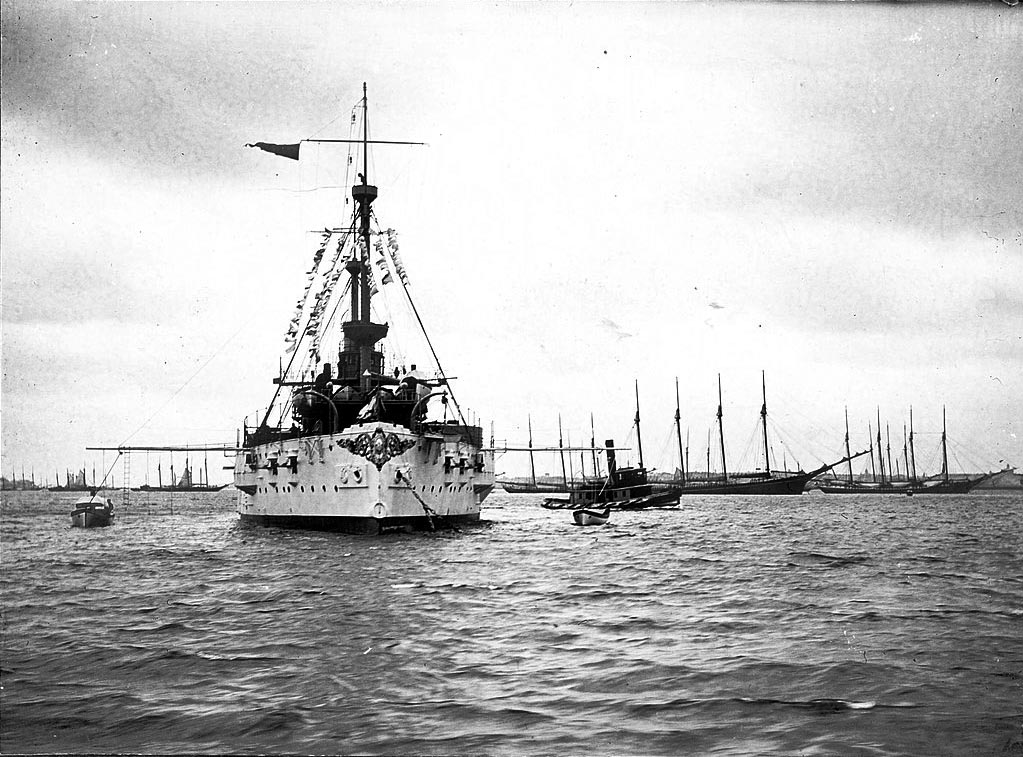
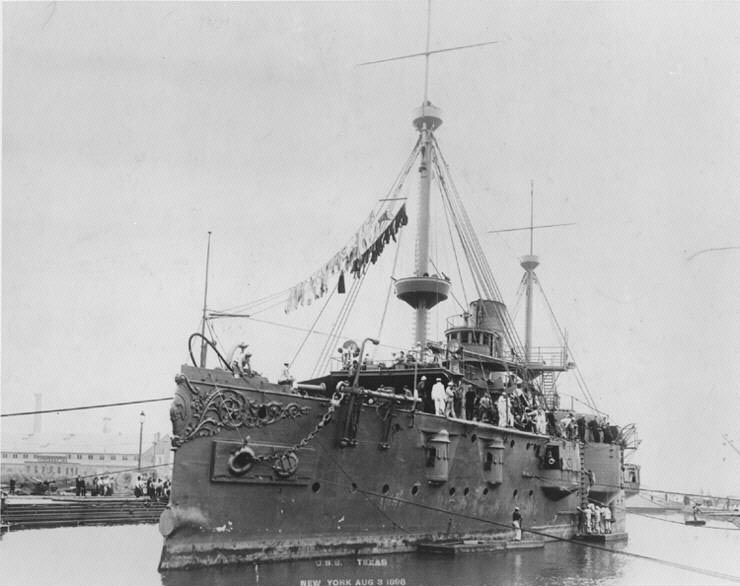
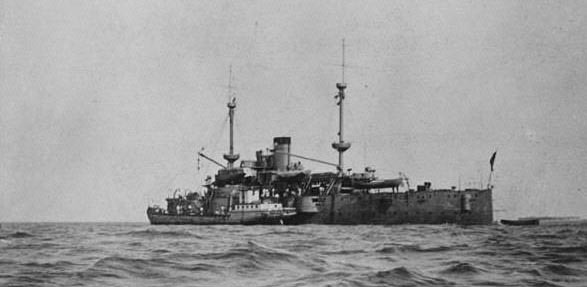
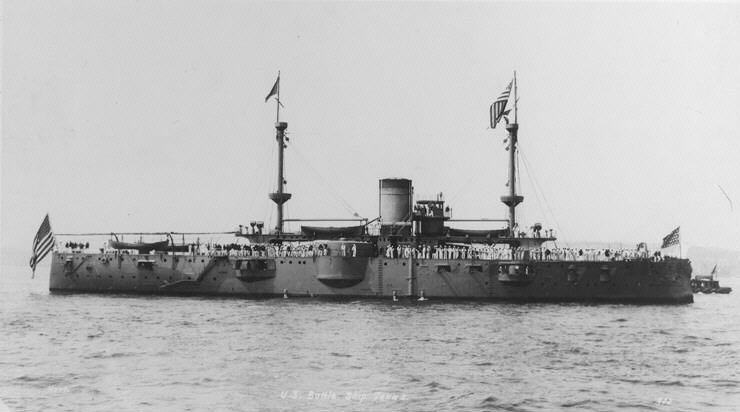
As a target ship
“Old Hoodoo” was decommissioned (11 January-1 September 1908) now as stationary station ship at Charleston, South Carolina. By 1910, one 37 mm (1.5 in) revolving gun and another 1-pdr gun were removed but two six-pounder guns added. She was regarded by the admiralty as obsolete by 1911, degraded to a gunnery target. The Navy wanted indeed to test her Harvey armpur, still widely used, against modern shells for her new dreadnought fleet. Fire tests would be performed botj on armored and unarmored parts, with underwater hits probabilities evaluated. They also wanted to note shattering or rupeture effects on pipes and all internal organs of the ship, as well as the flammability of her fittings, or penetration angles and force at long range.
Texas, to be renamed because a new dreadnoght was to be ordered under this name, was fully fitted out for it, all accomodation as station ship removed and dummies rigged to evaluate crew damage, at a cotal cost $29,422.70.
On 15 February 1911, recommissioned as a target shiop under the name of USS San Marcos she was tested in Chesapeake Bay for weeks, until sunk in shallow water in Tangier Sound, by 21–22 March 1911. USS New Hampshire (BB-25), a pre-dreadnought of the Connecticut-class battleships, finished her off. Most crucial knowledge was the examination of her hull, under the belt, showing so many holes below the waterline that flooding was complete. She sat, still emerging to serve as target for more time. Later she had interior fittings demolished. She was used for a torpedo experiment on 6 April and on 10 October at last she was stricken, but received a cage mast (Identical to the ones sported by the Florida-class) built atop her remains in 1912 to see the effects of 12-in shells. This time, she was fired upon by the monitor USS Tallahassee from 1,000 yards (910 m), on 21 August. The mast took nine hits but withstood the damage and confirmed the USN cage mast were the ideal solution, contrary to tripods.
In fact San Marcos (now no longer “USS San marcos”) as she was now reduced to wreck, was used in many occasions, in WWI, the interwar, and was still used for gunnery practice in 1940, but since she was submerged, her wreck only supported a canvas target screen, invisible below 2-6 feet below the surface, marked by an unlit buoy. The cargo ship Lexington missed it in 1940 and collided with her in low visibility. So she was now considered a hazard to navigation and was filled with tons of explosives to raze her upperworks and hopefully push her hull deeper into the mud. This was done actually in January 1959 but what keft of her can bee explored by divers today.
Read More
Books
Alden, John D. (1989). American Steel Navy: A Photographic History of the U.S. Navy from the Introduction of the Steel Hull in 1883 to the Cruise of the Great White Fleet. Annapolis, Maryland: Naval Institute Press (NIP).
Allen, Francis J. (1993). “”Old Hoodoo”: The Story of the U.S.S. Texas”. Warship International.
Friedman, Norman (1985). U.S. Battleships: An Illustrated Design History. NIP
Reilly, John C.; Scheina, Robert L. (1980). American Battleships 1896–1923: Predreadnought Design and Construction. NIP
Sieche, Erwin F. (1990). “Austria-Hungary’s Last Visit to the USA”. Warship International. XXVII (2)
Venzon, Anne, ed. (1992). General Smedley Darlington Butler: Letters of a Leatherneck 1898–1931. Greenwood.
Links
On dreadnoughtproject.org
On history.navy.mil/
12-in/30 Mk1 on navweaps
6-in/30 Mk1 on navweaps.com
On timesmachine.nytimes.com
On navsource.org
On spanamwar.com
On scientificamericanpast.com
On Munsey’s Magazine 1899
Model Kits
Iron Shipwrights N° 4-176 1:192 resin kit review
There is also the USS Texas 1895 US Navy Shipyard Plans from Navy Yard Norfolk, Virginia by Model Monkey
Ther is also a 1/350 Iron Shipwrights USS Texas 1898

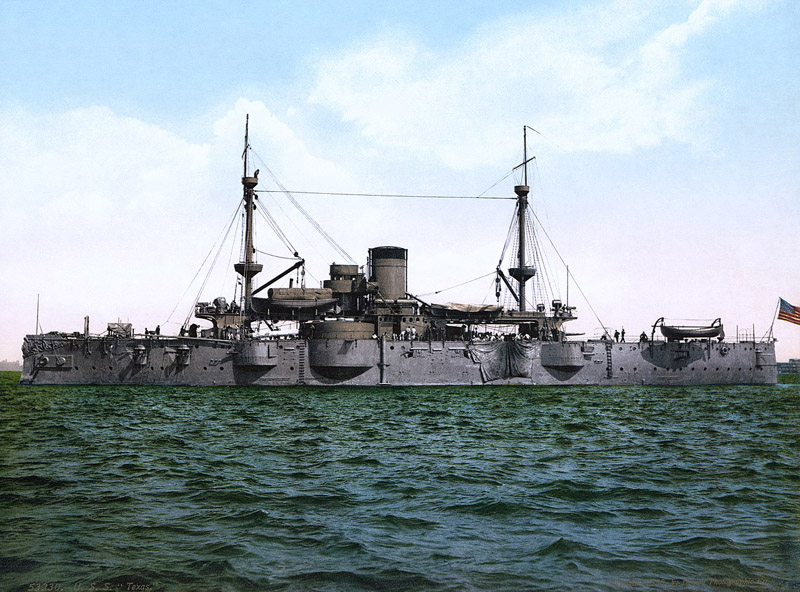
 Latest Facebook Entry -
Latest Facebook Entry -  X(Tweeter) Naval Encyclopedia's deck archive
X(Tweeter) Naval Encyclopedia's deck archive Instagram (@navalencyc)
Instagram (@navalencyc)





 French Navy
French Navy Royal Navy
Royal Navy Russian Navy
Russian Navy Armada Espanola
Armada Espanola Austrian Navy
Austrian Navy K.u.K. Kriegsmarine
K.u.K. Kriegsmarine Dansk Marine
Dansk Marine Nautiko Hellenon
Nautiko Hellenon Koninklije Marine 1870
Koninklije Marine 1870 Marinha do Brasil
Marinha do Brasil Osmanlı Donanması
Osmanlı Donanması Marina Do Peru
Marina Do Peru Marinha do Portugal
Marinha do Portugal Regia Marina 1870
Regia Marina 1870 Nihhon Kaigun 1870
Nihhon Kaigun 1870 Preußische Marine 1870
Preußische Marine 1870 Russkiy Flot 1870
Russkiy Flot 1870 Svenska marinen
Svenska marinen Søværnet
Søværnet Union Navy
Union Navy Confederate Navy
Confederate Navy Armada de Argentina
Armada de Argentina Imperial Chinese Navy
Imperial Chinese Navy Marinha do Portugal
Marinha do Portugal Mexico
Mexico Kaiserliche Marine
Kaiserliche Marine 1898 US Navy
1898 US Navy Sovietskiy Flot
Sovietskiy Flot Royal Canadian Navy
Royal Canadian Navy Royal Australian Navy
Royal Australian Navy RNZN Fleet
RNZN Fleet Chinese Navy 1937
Chinese Navy 1937 Kriegsmarine
Kriegsmarine Chilean Navy
Chilean Navy Danish Navy
Danish Navy Finnish Navy
Finnish Navy Hellenic Navy
Hellenic Navy Polish Navy
Polish Navy Romanian Navy
Romanian Navy Turkish Navy
Turkish Navy Royal Yugoslav Navy
Royal Yugoslav Navy Royal Thai Navy
Royal Thai Navy Minor Navies
Minor Navies Albania
Albania Austria
Austria Belgium
Belgium Columbia
Columbia Costa Rica
Costa Rica Cuba
Cuba Czechoslovakia
Czechoslovakia Dominican Republic
Dominican Republic Haiti
Haiti Hungary
Hungary Honduras
Honduras Estonia
Estonia Iceland
Iceland Eire
Eire Equador
Equador Iran
Iran Iraq
Iraq Latvia
Latvia Liberia
Liberia Lithuania
Lithuania Mandchukuo
Mandchukuo Morocco
Morocco Nicaragua
Nicaragua Persia
Persia San Salvador
San Salvador Sarawak
Sarawak Uruguay
Uruguay Venezuela
Venezuela Zanzibar
Zanzibar Warsaw Pact Navies
Warsaw Pact Navies Bulgaria
Bulgaria Hungary
Hungary

 Bundesmarine
Bundesmarine Dutch Navy
Dutch Navy Hellenic Navy
Hellenic Navy Marina Militare
Marina Militare Yugoslav Navy
Yugoslav Navy Chinese Navy
Chinese Navy Indian Navy
Indian Navy Indonesian Navy
Indonesian Navy JMSDF
JMSDF North Korean Navy
North Korean Navy Pakistani Navy
Pakistani Navy Philippines Navy
Philippines Navy ROKN
ROKN Rep. of Singapore Navy
Rep. of Singapore Navy Taiwanese Navy
Taiwanese Navy IDF Navy
IDF Navy Saudi Navy
Saudi Navy Royal New Zealand Navy
Royal New Zealand Navy Egyptian Navy
Egyptian Navy South African Navy
South African Navy






























 Ukrainian Navy
Ukrainian Navy dbodesign
dbodesign
This moment in time, for me I have to remember my best friend Larry Parker . Not knowing if he has survived a difficult career in the US Navy in the 19 70s , 80s, . My effort to find the record of work well done, highly likely is still w/out answer. Maybe he thinks about his childhood fondly.